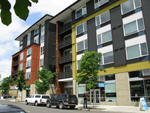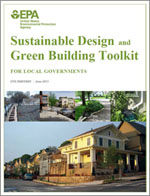Location
Background

Tupelo Alley is a LEED gold  apartment building in Portland, Oregon, close to downtown and within walking distance of stores, restaurants, and public transit.
apartment building in Portland, Oregon, close to downtown and within walking distance of stores, restaurants, and public transit.
Location-efficient siting, or locating a building within or near an existing community, is a smart growth strategy that connects particularly well with green building practices. Location is a crucial component of green building, as how people and goods get to and from the site affects the environmental performance of the building and its occupants.
Using smart growth principles and strategies can reduce the environmental impacts of buildings and development and enhance a community’s health and economy by offering a range of housing and transportation options and putting a mix of uses close together. These strategies help communities protect the natural environment by using resources more efficiently and making it easier for people to drive less if they choose. Location-efficient siting also results in less impervious surface per unit of development. Coupled with green building techniques that capture and filter rainwater, it can reduce polluted stormwater runoff, and make neighborhoods more attractive, economically stronger, and more socially diverse.
Location-efficient sites are often in previously developed areas that are served by existing infrastructure. Building in previously developed areas reduces the need for new streets, utility lines, water pipes, and other infrastructure, which reduces the environmental impact of development. It helps preserve open space and agricultural land by encouraging growth on already-developed sites. Building in previously developed areas can also create opportunities for neighborhood revitalization through reuse and renovation of existing structures. (The report Location Efficiency and Housing Type - Boiling it Down to BTUs discusses the impact of different development approaches.) Historic buildings, vacant lots, abandoned properties, brownfields, and greyfields can be transformed into a green development that supports the local economy and strengthens the community’s character.
EPA Resources
Technical Assistance
EPA’s Office of Sustainable Communities provides technical assistance to help interested communities achieve their development goals, improve their quality of life, and become more economically and environmentally sustainable. The following technical assistance programs can help communities consider green building-related challenges:
- Building Blocks for Sustainable Communities: Quick, targeted technical assistance using a variety of tools to implement smart growth development approaches. One tool is a Green Building Toolkit, which helps local governments identify policies that support compact development that features sustainably built homes and buildings.
- Smart Growth Implementation Assistance: In-depth technical assistance for tribal, state, regional, and local governments that are seeking help with a smart growth-related challenge.
Tools
- Green Building Standards: This web page compares the major model codes and rating systems that communities may use to develop green building programs and revise building ordinances.
- Smart Location Database: A National Dataset for Characterizing Accessibility and the Built Environment at the Neighborhood Scale: This database characterizes several built environment and regional accessibility variables for every census block group in the United States. The data can be used in scenario planning, travel demand studies, and more.
- Sustainable Design and Green Building Toolkit for Local Governments (PDF) (110 pp, 1.1MB, About PDF): The toolkit helps local governments identify and remove barriers to sustainable design and green building in existing codes and ordinances. The toolkit includes an assessment tool and resource guide, as well as a guide to developing a plan for implementing changes in a community’s permitting process. The toolkit also provides an Assessment Tool in Excel (XLSX) (184K) that local governments can use to evaluate their codes and ordinances. Instructions appear on the opening tab.
- Trip Generation Tool for Mixed-Use Developments: This spreadsheet tool makes it easy for users to estimate trips generated by a new mixed-use development.
- Smart Growth Guidelines for Sustainable Design and Development: The guidelines help users ensure that programs, plans, and proposed developments incorporate the elements needed at the location, site, and building levels to result in more environmentally sustainable, affordable housing.
- Smart Growth Scorecards: The scorecards help communities assess their policies and proposed development projects.

National Award for Smart Growth Achievement Green Building Award Winners
Since 2002, EPA has recognized communities that use innovative policies and strategies to strengthen their economies, provide housing and transportation choices, and protect the environment through the National Award for Smart Growth Achievement. The following communities received an award for their outstanding work in smart growth and green:
- 2011 - Silver Gardens Apartments (Albuquerque, New Mexico): This 66-unit affordable housing development is located on a reclaimed brownfield site in downtown Albuquerque across the street from the city's primary transit hub. Silver Gardens is the Southwest's first LEED-Platinum affordable housing development and the first affordable housing project in the nation to sell carbon offsets. Video.
- 2010 - Miller’s Court (Baltimore, Maryland): Miller's Court integrates mixed-use redevelopment with preservation of a landmark historic building and sustainable design principles, such as location-efficient siting, sustainable materials, water and energy efficiency, natural lighting, indoor air quality, and innovative design. Video.
- 2009 - Tempe Transportation Center (Tempe, Arizona): This multi-use green facility is a transportation hub and gathering spot for the community that replaced a 2.7-acre surface parking lot. Video.

A view from a Miller's Court apartment with its large windows for daylighting.
Publications
- Our Built and Natural Environments: This report summarizes technical research on the relationship between the built and natural environments and the role of development patterns, urban design, and transportation in improving environmental quality.
- Location Efficiency and Housing Type - Boiling it Down to BTUs: This paper illustrates the relative impact of different development approaches: locating homes where less energy-intensive transportation options are available; constructing homes that use less energy because they share walls, which reduces heat loss; and greening homes and cars through energy-efficient home construction techniques and fuel-efficient automobile technology. Its findings suggest that the most significant gains in household energy efficiency can be achieved when all these efforts are combined.

Case Studies
- Ranson-Charles Town Corridor Project (PDF) (2 pp, 880K, About PDF) (Ranson and Charles Town, West Virginia): In May 2011, the city of Ranson received technical assistance through EPA's Building Blocks for Sustainable Communities Program to coordinate three federal grants and execute the plan that transformed Fairfax Boulevard into a walkable and bikeable green corridor. The city of Charles Town used the grants to transform a dilapidated historic building into a regional commuter center in downtown, providing residents and workers with access to more transportation options.
Other Resources
Location Affordability Portal
- Location Affordability Portal:
 This tool, produced by the U.S. Department of Housing and Urban Development and the U.S. Department of Transportation, can help consumers, researchers, and policymakers better understand the impact of transportation costs on housing affordability.
This tool, produced by the U.S. Department of Housing and Urban Development and the U.S. Department of Transportation, can help consumers, researchers, and policymakers better understand the impact of transportation costs on housing affordability.
![[logo] US EPA](../gif/logo_epaseal.gif)